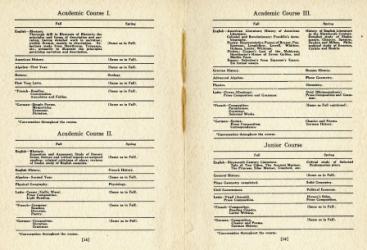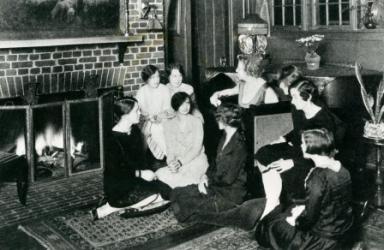"A Proper Education for Young Ladies" in 1911

The formal college catalogs expressed the “ideal” academic curriculum, since they were designed to appeal to parents as well as prospective students. The course listings promote the educational philosophy of the current school owners and leaders, and reflected contemporary ideas about the role of education for the young women.
For example, the 1911 Catalog prepared by the founders of the school, the Rev. and Mrs. Samuel N. Barker, contains a detailed presentation of academic course work for all five grade levels (corresponding to the last three years of high school and two years after high school). It suggests a very rigorous program of study. Students in the first level of the high school program studied English, American History, Algebra, Botany, Zoology, Latin, French and German. Students in the highest of the five levels, the “Senior Course,” read novels, study art history, mythology, geology, astronomy, sociology, trigonometry, Latin, French, and German.
In addition to these academic courses, Chevy Chase College and Seminary, as it was called at that time, offered classes in music, art, expression (speech), dancing, physical education, and the domestic arts.
Examinations are “abolished” by the Barkers
But if prospective students and their parents were concerned about the daunting requirements of the academic curriculum, they might have been pleased to learn that the Barkers did not believe in examinations:
Each day of the week followed a regular schedule. The 1913-14 Catalog included the following "Daily Program," and shows that the morning was reserved for classes, the afternoon for other activities such as music and sports, and the hours after dinner for studying:
Rising Bell |
6:45 am |
Prayers |
7:30 am |
Breakfast |
7:45 am |
Study and Recitations |
8:30 am to 1:00 pm |
Luncheon |
1:00pm |
The afternoon is taken up with recreation, practice, gymnastics, athletics, Domestic Science work, etc.
Dinner |
6:00 pm |
Study |
7:30 pm to 9:30 pm |
Lights Out |
10:00 pm |
A Modern Movement for Girl’s Education
Dr. Frederic Farrington, the second owner of the school who served as principal and then president from 1917 until his sudden death in 1930, outlined a different approach to education for young women. In the 1917 College Catalog, Farrington called his approach part of “a modern movement in girls’ education.” He recognized the “world-wide movement for the emancipation of woman,” but declared that woman’s “chief work will inevitably be in the home.” Thus, Chevy girls should be able to read, write and speak the English language. They should know mathematics, all the better to handle household accounts. Their “social studies” should focus on social progress; their science courses should prepare them to understand the importance of scientific processes. Instead of Latin and Greek, they should learn the modern languages, and develop a linguistic pluralism.

Catalogue 1928-1929, CCHS 1995.06.07
Home economics, however, was a particularly important subject for Chevy Chase students under Dr. Farrington because the graduates “will eventually have homes of their own” and they will need to learn how to direct the work of servants, dressmakers, milliners and others. “Physical vigor” was important, too, and the suburban location of Chevy Chase was the ideal setting for regular outdoor exercise. Finally, the fine arts as well as crafts provided the opportunity for self-expression. This approach reflected Dr. Farrington’s view of education for elite young women, one that embraced elements of progressive ideology yet accepted women’s domestic role as primary.
Home Economics / Domestic Science

The emphasis on home economics persisted. In 1939, the college purchased a “domestic practice house” to be used in the instruction of the girls. Acquired by Mrs. Farrington, then the Regent of the school, the six-bedroom Dutch Colonial house at 3 Thornapple Street served as a “campus for practical experience in home-making by the students.” For six weeks a group of girls lived at the house, taking turns acting as hostess, cook, and home manager, and were responsible for planning and executing meals. They also took classes in sewing, textiles, and household management.


